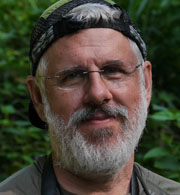Biological Science Faculty Member - Retired
Dr. David Houle
- Office: 4063 King Life Sciences
- Office: (850) 645-0388
- Area: Ecology & Evolution
- Lab: King Life Sciences
- Lab: (850) 645-0389
- Fax: (850) 645-8447
- Mail code: 4295
- E-mail: dhoule@bio.fsu.edu

Professor
Ph.D., State University of New York at Stony Brook, 1988
Research and Professional Interests:
I am an evolutionary geneticist, currently studying the evolution of development and how it affects morphology. The biggest unknowns in biology are the paths through which genetic variation affects the phenotype, and in turn how the phenotype affects organismal fitness. I believe that we need to greatly increase our ability to measure phenotypic characteristics, the phenome, before we can understand this genotype-phenotype-fitness map. We use phenomic approaches in Drosophila melanogaster, the fruit fly, to get at these questions, using a combination of molecular, genetic, and whole-organism techniques. Our current projects characterize the variation produced by particular genes and developmental mechanisms, characterize the genetic variation in natural populations, and seek to explain how that variation can be used to produce evolutionary responses. I have undertaken a wide variety of other projects in the past, and I am still interested in mutation, sexual selection, life history evolution, fluctuating asymmetry and measurement theory.
Selected Publications:
Copies of most of these papers are available from the Publications page of my Personal Home Page. 
Mezey, J. G., and D. Houle. 2005. The dimensionality of genetic variation for wing shape in Drosophila melanogaster. Evolution 59:1027-1038.
Hansen, T. F., and D. Houle. 2008. Measuring and comparing evolvability and constraint in multivariate characters. Journal of Evolutionary Biology 21:1201-1219.
Houle, D. Govindaraju, D. R. and S. Omholt. 2010. Phenomics: the next challenge. Nature Reviews Genetics 11:855-866.
Houle, D. C. Pelabon, G. P. Wagner, T. F. Hansen. 2011. Measurement and meaning in biology. Quarterly Review of Biology 86:1-32.
Carter, A. J. R., and D. Houle. 2011. Artificial selection reveals heritable variation for developmental instability. Evolution 65:3558-3564.
Hansen, T. F., C. Pelabon, and D. Houle. 2011. Heritability is not evolvability. Evolutionary Biology 38:258-277.
Houle, D. and J. Fierst. 2013. Properties of spontaneous mutational variance and covariance for wing size and shape in Drosophila melanogaster. Evolution 67:1116-1130.
Schrider, D., D.Houle, M. Lynch and M. W. Hahn. 2013. Rates and genomic consequences of spontaneous mutational events in Drosophila melanogaster. Genetics. 194:937-954.
Matamoro-Vidal, A., I. Salazar-Ciudad, and D. Houle, 2015 Making quantitative morphological variation from basic developmental processes: where are we? The case of the Drosophila wing. Developmental Dynamics 244:1058-1073.
Ray, R. P., Matamoro-Vidal, A., Ribiero, P. S., Tapon, N., Houle, D., Salazar-Ciudad, I. and Thompson, B. J. 2015. Patterned anchorage to the apical extracellular matrix defines tissue shape in the developing appendages of Drosophila. Developmental Cell 34:310-322.
Bolstad, G. H., J. A. Cassara, E. Márquez, T. F. Hansen, K. Van Der Linde, D. Houle, and C. Pélabon. 2015. Complex constraints on allometry revealed by artificial selection on the wing of Drosophila melanogaster. Proc. Natl. Acad. Sci. USA 112:13284–13289.
Hollis, B., D. Houle, and T. J. Kawecki. 2016. Evolution of reduced post-copulatory molecular interactions in Drosophila populations lacking sperm competition. J. Evol. Biol. 29:77-85.
Houle, D., G.H. Bolstad, K. Van Der Linde, and T.F.H. Hansen. 2017. Mutation predicts 40 million years of fly wing evolution. Nature 548: 447-450.

